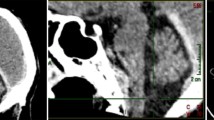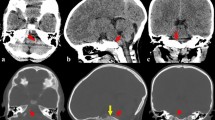Abstract
Background
Traumatic retroclival epidural hematoma is very rare and only a few cases are described in literature. All previous cases occurred in the pediatric population and were classically seen in pedestrians or cyclists hit by speeding motor vehicles. It is probable that horizontal articulation between the cranium and the atlas and ligamentous laxity at the craniocervical junction in this age group predispose them to ligamentous injury at the craniospinal junction and formation of retroclival hematoma. MRI or three-dimensional reconstructed CT is considered essential for diagnosing this condition. Conservative treatment is an option if neurological deficits are mild and brainstem compression is not significant. Bony fixation is, however, required if there is suspicion of instability.
Case Report
The authors describe the case of an 8-year-old girl who developed traumatic retroclival epidural hematoma after a motor vehicle accident and who was managed conservatively with good recovery.
Conclusion
This case and the review of literature suggest that retroclival epidural hematoma is a pediatric entity usually associated with ligamental injury at the craniocervical junction.




Similar content being viewed by others
References
Bucholz RW, Burkhead WZ (1979) The pathological anatomy of fatal atlanto-occipital dislocations. J Bone Joint Surg Am 61:248–250
Kaufman RA, Carroll CD, Buncher CR (1987) Atlantooccipital junction: standards for measurement in normal children. AJNR 8:995–999
Kurosu A, Amano K, Kubo O, Himuro H, Nagao T, Kobayashi N, Kakinoki Y, Kitamura K (1990) Clivus epidural hematoma. Case report. J Neurosurg 72:660–662
Marks SM, Paramaraswaren RN, Johnston RA (1997) Transoral evacuation of a clivus extradural haematoma with good recovery: a case report. Br J Neurosurg 11:245–247
Mizushima H, Kobayashi N, Sawabe Y, Hanakawa K, Jinbo H, Iida M, Iwata T, Matsumoto K (1998) Epidural hematoma of the clivus. Case report. J Neurosurg 88:590–593
Orrison WW, Rogde S, Kinard RE, Williams JE, Torvik A, Sackett JF, Amundsen P (1986) Clivus epidural hematoma: a case report. Neurosurgery 18:194–196
Papadopoulos SM, Dickman CA, Sonntag VK, Rekate HL, Spetzler RF (1991) Traumatic atlantooccipital dislocation with survival. Neurosurgery 28:574–579
Suliman HM, Merx HL, Wesseling P, van der Sluijs B, Vos PE, Thijssen HO (2001) Retroclival extradural hematoma is a magnetic resonance imaging diagnosis. J Neurotrauma 18:1289–1293
Yang BP (2003) Traumatic retroclival epidural hematoma in a child. Pediatr Neurosurg 39:339–340
Author information
Authors and Affiliations
Corresponding author
Rights and permissions
About this article
Cite this article
Agrawal, D., Cochrane, D.D. Traumatic retroclival epidural hematoma—a pediatric entity?. Childs Nerv Syst 22, 670–673 (2006). https://doi.org/10.1007/s00381-006-0059-x
Received:
Published:
Issue Date:
DOI: https://doi.org/10.1007/s00381-006-0059-x




